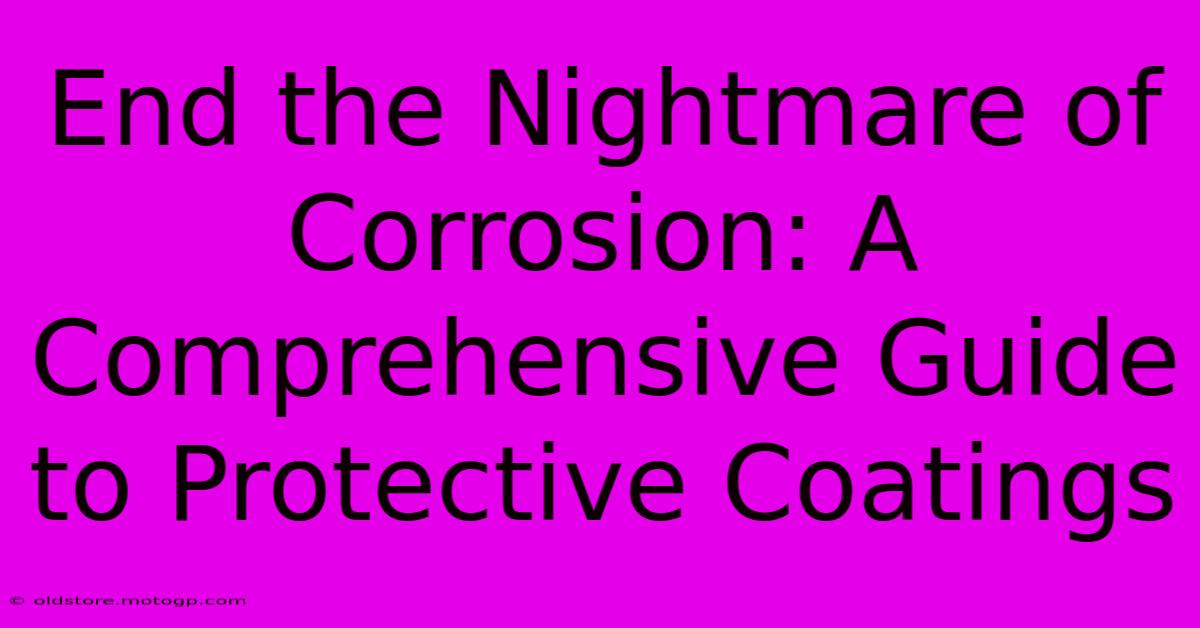End The Nightmare Of Corrosion: A Comprehensive Guide To Protective Coatings

Table of Contents
End the Nightmare of Corrosion: A Comprehensive Guide to Protective Coatings
Corrosion. The silent destroyer. It eats away at metals, compromising structural integrity, leading to costly repairs, and even posing safety hazards. But the nightmare doesn't have to continue. This comprehensive guide delves into the world of protective coatings, offering you the knowledge to choose the right solution and effectively combat corrosion.
Understanding the Enemy: Types of Corrosion
Before we explore solutions, it's crucial to understand the enemy. Corrosion isn't a single entity; it manifests in various forms, each requiring a tailored approach. Some common types include:
- Uniform Corrosion: This is the most common type, where the corrosion happens evenly across the surface. Think of a rusty nail.
- Pitting Corrosion: Localized corrosion that creates small holes or pits in the metal surface. This is particularly insidious as it can lead to structural failure unexpectedly.
- Galvanic Corrosion: Occurs when two dissimilar metals are in contact in the presence of an electrolyte (like water). The more active metal corrodes preferentially.
- Crevice Corrosion: Concentrated corrosion within crevices or gaps where oxygen access is limited.
- Stress Corrosion Cracking: A combination of tensile stress and a corrosive environment that leads to cracking and failure.
The Arsenal Against Corrosion: Types of Protective Coatings
Choosing the right protective coating depends heavily on the type of corrosion, the environment, and the substrate material. Here's a breakdown of common coating types:
1. Organic Coatings: The Versatile Protectors
- Paints: The most common and versatile option, available in various formulations (e.g., epoxy, polyurethane, acrylic) for different needs and environments. Offer good protection against atmospheric corrosion.
- Varnishes: Primarily used for aesthetic purposes and providing a protective layer against UV degradation and minor wear.
- Epoxies: Known for their exceptional adhesion, chemical resistance, and durability, making them suitable for harsh environments.
2. Inorganic Coatings: The Heavyweights
- Zinc Coatings (Galvanizing): A cost-effective method involving coating the base metal with zinc. Zinc acts as a sacrificial anode, protecting the underlying steel.
- Ceramic Coatings: Highly resistant to high temperatures, chemicals, and abrasion. Ideal for applications in extreme environments.
- Metal Cladding: The base metal is covered with a more corrosion-resistant metal, such as stainless steel. Offers excellent protection but can be more expensive.
3. Specialized Coatings: Tailored Solutions
- Powder Coatings: Applied as a dry powder and cured using heat. Offer excellent durability and scratch resistance.
- Conversion Coatings: These coatings are formed by chemical reactions on the metal surface, creating a protective layer. Chromate conversion coatings are commonly used but are being phased out due to environmental concerns.
Selecting the Right Coating: A Strategic Approach
Choosing the appropriate coating is crucial for effective corrosion protection. Consider these factors:
- Substrate Material: The base material dictates the compatibility and adhesion of the coating.
- Environment: The level of humidity, temperature, exposure to chemicals, and other environmental factors will significantly impact the coating's performance.
- Cost: Balance the cost of the coating with its longevity and effectiveness.
- Application Method: The method of application – brushing, spraying, dipping – will also influence the final result.
Beyond Application: Maintenance is Key
Applying a protective coating is only half the battle. Regular inspection and maintenance are essential to ensure long-term protection. This might involve:
- Regular visual inspections: Check for any signs of damage, cracking, or peeling.
- Cleaning: Remove dirt, debris, and other contaminants that can compromise the coating's integrity.
- Recoating: When necessary, recoat the surface to maintain its protective capabilities.
Conclusion: A Corrosion-Free Future
Corrosion is a formidable adversary, but with the right knowledge and the proper application of protective coatings, you can conquer it. By understanding the different types of corrosion, selecting the appropriate coating, and implementing a robust maintenance plan, you can significantly extend the lifespan of your assets and prevent costly repairs and safety hazards. The nightmare of corrosion doesn't have to be your reality. Choose wisely, and protect your investments effectively.

Thank you for visiting our website wich cover about End The Nightmare Of Corrosion: A Comprehensive Guide To Protective Coatings. We hope the information provided has been useful to you. Feel free to contact us if you have any questions or need further assistance. See you next time and dont miss to bookmark.
Featured Posts
-
Elevate Your Email Game Discover The Best Mailhosting For Personalized Domains
Feb 07, 2025
-
Transform Your Home Zone Lighting Techniques To Enhance Every Room
Feb 07, 2025
-
The Perfect Expression Of Affection Discover Enchanting Valentines Day Valentine Cards
Feb 07, 2025
-
Open Your Spiritual Eyes The Colors Of Gods Kingdom Revealed
Feb 07, 2025
-
Gel Polish Perfection Dnd Dcs Unrivaled Formula For Long Lasting Shine
Feb 07, 2025
